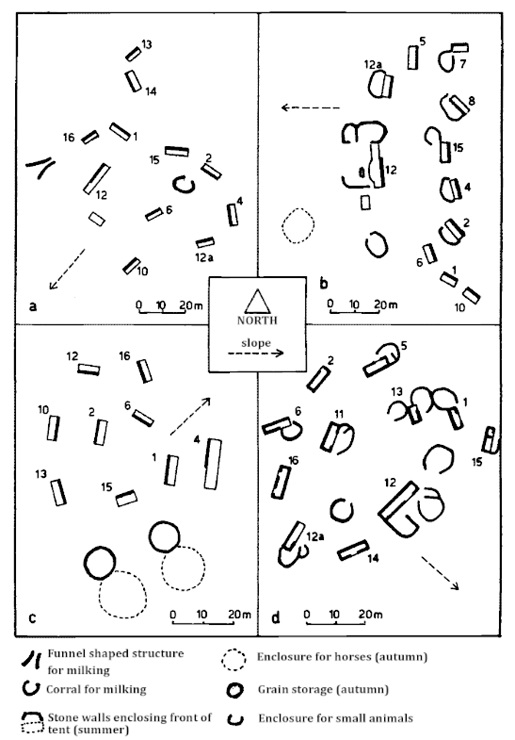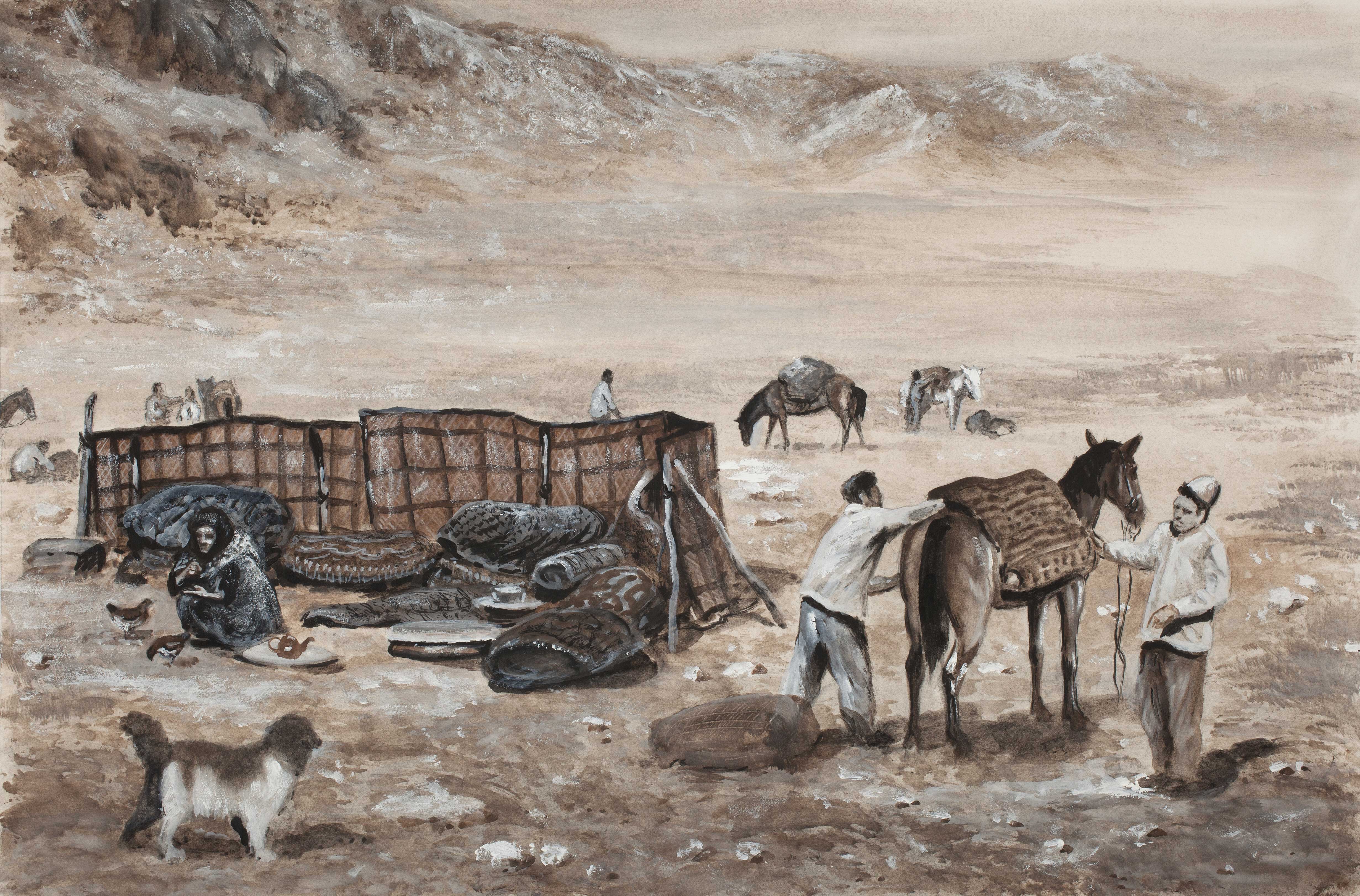One of the most famous insights into the culture of herdsmen engaged in transhumance migration was presented by Frank Hole in the 1970’s. This American archaeologist travelled with Iranian pastoralists on their regular journey from their winter to their summer pastures. The reason for undertaking this anabasis was an attempt to find clues regarding the origins and the spreading of domesticated plants and animals during the Neolithic. He carried out his research in the area of the Deh Luran plain located in the foothills of the Zagros Mountains in southwest Iran, one of the presumed cradles of agriculture.
 |
| Diversity in campsite organisation of the Bakhtiari nomads (southwestern Iran, dialect belonging to the Luri linguistic family). Figures depict plans of four consecutive seasonal camps. Numbers indicate tents of particular families, and are coherent throughout figures. Number 12 belongs to the tent or tents of the headman. Author J. P. Digard, after Cribb 1991, 142). |
His research focused on the observation of one of the migrating communities, the Baharvand (a tribe pertaining to the Luri language family), took place in 1973. In terms of the extensive written history of the ancient Persia and of Persia in the Middle Ages, the Luri and Bakhtiari nomads and all their predecessors had remained relatively unnoticed.
The main sources of the livelihood of the Baharvand nomads were sheep, goats and a few cows. In addition, they also owned donkeys and mules, on which they loaded their tents and luggage when they were travelling. They considered riding horses, which were bred primarily for the pleasure and the prestige of their owners, to be the most valuable animals. During Hole’s presence there about a quarter of all the members of the Baharvand tribe were still engaged in herding as the main or the sole means of their livelihood. Their life was not affected either by the administration nor by economic situation in the department of the state in which they lived, or the fact that historic caravan routes that linked the major cities passed through this area.
The territory, through which the pastoralists moved their herds from their summer to their winter pastures, included rocky mountains and belts of flat areas with sparse sources of running water enclosed between them. The country and people’s lives in it suffered from the large fluctuations of temperature and of moisture. Frank Hole considered this phenomenon as being the prime motivator of the migratory herding economy of the Baharvand people.
The winter pastures were usually located in low-lying valleys, as opposed to summer pastures that were found at higher altitudes, usually surrounded by woods. The nomad camps were comprised of tents, while in summer structures called kula were made of sticks and branches, which were typical for Luristan. In combination with the daub-insulated walls such dwellings were frequently used as the “main house” in the home area, from where transhumance expeditions were initiated. Inside the campsite the family households (generally numbering 4 to 6) were separated by spaces of cca. 10 m between each of them. The tents and/or the alternative shelters were arranged in two rows, sometimes on one side and sometimes on both sides of the corral. The specific arrangement of the dwellings depended on several factors, however, amongst others, on the current relations with neighbours. The shared decisions of the residential community were sometimes spatially bound to a specific structure constituting a large stone shelter.
Based on the data collected from his research, Frank Hole created an ethnoarchaeological model of nomad camps. He had discovered that their sites were located on the seasonal migration routes of the pastoralists and had no spatial relationship to the fields nor to the water sources. The camps were inhabited repeatedly over a long period, though sometimes with time gaps, even for as many as several years. Accurate dating based on archaeological evidence was made difficult, specifically because a palimpsest of artefacts was found in these places dating from various different stages of settlement. The houses that were built were temporary. On the other hand, nomads liked to reutilise ancient objects, even those of a prehistoric age. In addition to their own residential buildings, the herders built heating systems in their camps and also structures that they used for storing grain and acorns.
|
|
| In Luristan (western Iran) the nomads move from their winter refuges that are located in sheltered valleys to their summer pastures that are high in the mountains. This illustration was created by Petr Modlitba based on a documentary photograph from the 1970’s kindly provided by Frank Hole. |
Want to learn more?
- Cribb, R. 1991. Nomads in Archaeology. Cambridge: Cambridge University Press.
- Hole, F. 1978. Pastoral nomadism in western Iran. In Explorations in ethnoarchaeology, ed. R. A. Gould, 127-167. Albuquerque: University of New Mexico Press.
 Archeologické 3D virtuální muzeum
Archeologické 3D virtuální muzeum

.jpg)
